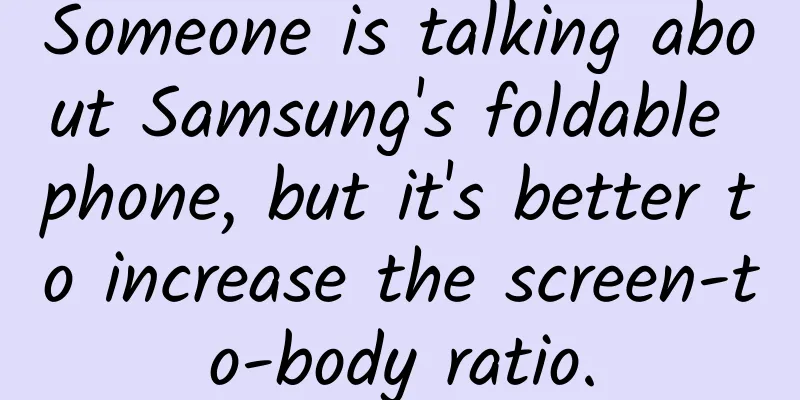Someone is talking about Samsung's foldable phone, but it's better to increase the screen-to-body ratio.

|
In most cases, doing something different should be done to make the product better, not just for the sake of being different. Recently, there are more and more news about Samsung developing foldable screen phones, and many media predict that foldable screen phones will bring a "revolution" to mobile phone products in 2017. Various judgments based on the wind and rain may make Samsung's screen suppliers a little panicked. Public opinion is waiting for foldable screen phones, which will inevitably affect the sales of curved screens. Kim Tae-woong, chief engineer of Samsung Display, a display panel manufacturer under Samsung, then said that due to the continued popularity of curved screen phones and some technical challenges, foldable screen phones may not be available until 2019. This can be regarded as pouring cold water on the calls from the market, and this cold water is really well poured. Samsung officially launched curved screen mobile phones in the S6 era, and has now gone through several generations of products including S6 Edge, S6 Edge+, S7 Edge, Note 7, and S8. Although the curved screen is only a unique design with differentiated appearance in actual use, without much functional improvement, consumers are still very fond of this design. Many domestic manufacturers also began to follow the curved screen design last year to promote their products to a higher-end position. In fact, in the current mobile phone market, we can find an obvious trend: "Appearance is the primary productive force." The improvement in functions and performance has reached a bottleneck, and good-looking design can directly attract more consumers. Although many manufacturers are currently making curved screen products, from the experience of using real machines, there are really not many products that can achieve a similar level to Samsung. The unique product design of the curved screen also provides a strong foundation for Samsung's flagship phones to be priced at a premium. Until now, the curved screen still has an operating profit margin of about 20%, and consumers are still buying into it. But if the demand for curved screens decreases over time, is it a good idea to launch foldable screens? From the perspective of product usability, foldable screens may not be very reliable. In fact, Sony has tried the concept of folding screen in 2011. In 2011, Sony released a tablet computer called Tablet P. The overall shape is like a glasses case. When opened, it is two separate screens. Although it cannot be regarded as the most rigorous "folding screen", the design idea is similar. However, due to the limitations of the technology at the time, this product with a strange design had several embarrassing problems: 1. The body is very thick 2. The screen border is touching 3. The overall shape makes people feel at a loss when actually using it. 4. It is not a true folding screen, and the gap in the middle of the screen still gives people a strong sense of tearing. Five years have passed, how has foldable screen technology developed? During 2016, many curved screen patents applied by Samsung were exposed. According to the exposure, this phone code-named Galaxy X looks like an elongated version of the current ordinary mobile phone. The screen is flexible and can be folded or bent on the front with a hinge design similar to Surface. The overall design looks a bit like the fully foldable LG Flex phone. The design of stretching the screen also seems to be Samsung's style. After all, on the newly released Galaxy S8, Samsung directly stretched the screen ratio to 18.5:9 in order to increase the screen-to-body ratio. After using a bendable screen, it is not a bad idea to make the screen into a 21:9 "fish screen" on the phone. Although the curved screen mobile phones on the market now do not have many practical functions, they can provide users with a strong visual impact and significantly improve the overall grip of the phone. If foldable screens appear in the future, the shape of mobile phones will return to the shape of flip phones. Although some problems have been solved, such as the screen size has increased, the flip design does not need to worry about scratching the screen when it is stored, and the visual impact when the screen is opened is also quite amazing. But if we think about it calmly, making foldable screens may not be as practical as trying to increase the screen-to-body ratio. A high screen-to-body ratio can also enhance the visual impact of the body's appearance, and the enlarged screen size can also give users more operating space. Just like what Luo Yonghao said about the high screen-to-body ratio in his Momo live broadcast: Currently, the functionality of smartphones is basically all realized through the screen, so from an ideal perspective, borderless design is the simplest. If there is a chance to ensure that the product function and performance are not lost, a borderless pure screen is the best. The current situation is that in order to achieve borderless display, when the earpiece is removed and replaced with other technologies, many functions and performances will be compromised. Therefore, the current development of truly borderless or full-screen products actually has more experimental significance than practical use significance. Therefore, it is foreseeable that in the next two years, few manufacturers will explore the form of folding screens, but will spend more energy to explore how to maximize the screen-to-body ratio while ensuring basic functions. This will not only improve the overall appearance of the body for users, but also provide more screen vision with a larger screen-to-body ratio. For example: when playing Honor of Kings with iPhone and Samsung S8, you have a wider field of view with Samsung S8. Do you think the high screen-to-body ratio screen with a long strip ratio is practical? As a winner of Toutiao's Qingyun Plan and Baijiahao's Bai+ Plan, the 2019 Baidu Digital Author of the Year, the Baijiahao's Most Popular Author in the Technology Field, the 2019 Sogou Technology and Culture Author, and the 2021 Baijiahao Quarterly Influential Creator, he has won many awards, including the 2013 Sohu Best Industry Media Person, the 2015 China New Media Entrepreneurship Competition Beijing Third Place, the 2015 Guangmang Experience Award, the 2015 China New Media Entrepreneurship Competition Finals Third Place, and the 2018 Baidu Dynamic Annual Powerful Celebrity. |
>>: Samsung S8+ battery life test: completely beaten by iPhone 7 Plus
Recommend
People in this group should be careful when getting the new coronavirus vaccine!
Spring is the peak season for pollen allergies Ca...
Unboxing the Xiaomi Router Youth Edition: A Must-Have for College Dormitories
On August 13, 2015, Xiaomi launched the Xiaomi Ro...
"Beijing Swift" now a college entrance examination question! Uncover the legendary story of the bird that "never lands"
The "Beijing Swift" will be included in...
Why do we sometimes have to wait for half an hour for a bus that runs every 10 minutes?
Commuting is a topic that modern people cannot av...
World Water Day丨How to love and protect water?
How much water should a person drink a day? Today...
Being too clean can also make you sick! Get rid of these 6 "good habits" as soon as possible
“Doctor, I love cleanliness so much, how come I s...
Mr. Yuan Haotong – Mixing and post-production
Teacher Yuan Haotong - Introduction to mixing and...
Google removes Android One's two-year system update guarantee
According to foreign media reports, Google has qu...
How much does it cost to outsource mini program development?
What is mini program outsourcing development? How...
Polluting the environment? Destroying the ecology? Fertilizers feel wronged
Since the birth of the first chemical fertilizer,...
From now on, we have one less open source mobile phone system
Firefox OS, a bold attempt by traditional browser...
How to make money through online promotion?
1. We-media It refers to the general term for new...
How do mini programs obtain traffic? How to get traffic for your mini program?
Zhang Xiaolong once mentioned in a WeChat open cl...
How difficult is it to prevent floods in the Yangtze River?
↑A group of National Geographic fans, focusing on...
Essential for contacting Apple! The most complete official contact information of App Store! Updated July 2017
The main contact methods currently published by A...









